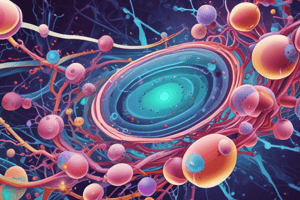Podcast
Questions and Answers
Which of the following mechanisms of antibiotic resistance involves the breakdown of antibiotics by enzymes?
Which of the following mechanisms of antibiotic resistance involves the breakdown of antibiotics by enzymes?
- Efflux pumps
- Plasmid transfer
- Beta-lactamase production (correct)
- Target modification
Which group of people is at high risk of developing severe zoonotic diseases from Salmonella?
Which group of people is at high risk of developing severe zoonotic diseases from Salmonella?
- Healthy adults
- Immunocompromised individuals
- Pregnant women
- All of the above (correct)
What is a common symptom of gastrointestinal infections caused by Salmonella?
What is a common symptom of gastrointestinal infections caused by Salmonella?
- Fever
- Abdominal pain
- Diarrhea
- All of the above (correct)
What is the primary goal of vaccine development against Salmonella?
What is the primary goal of vaccine development against Salmonella?
Which of the following is a challenge in developing effective vaccines against Salmonella?
Which of the following is a challenge in developing effective vaccines against Salmonella?
What is the primary route of transmission of Salmonella from animals to humans?
What is the primary route of transmission of Salmonella from animals to humans?
What is the purpose of bacterial culture in diagnostic testing for Salmonella?
What is the purpose of bacterial culture in diagnostic testing for Salmonella?
Which type of vaccine is designed to introduce a weakened form of Salmonella into the body?
Which type of vaccine is designed to introduce a weakened form of Salmonella into the body?
Flashcards are hidden until you start studying
Study Notes
Antibiotic Resistance
- Enterobacteriaceae, including Salmonella, are increasingly resistant to antibiotics, making treatment challenging.
- Resistance is often mediated by plasmids, which can be easily transferred between bacteria.
- Common resistance mechanisms include:
- Beta-lactamase production
- Efflux pumps
- Target modification
- Antibiotic misuse and overuse in veterinary medicine contribute to the development of resistant strains.
Zoonotic Diseases
- Salmonella can be transmitted from animals to humans, causing zoonotic diseases.
- Risk groups include:
- Immunocompromised individuals
- Pregnant women
- Young children
- Elderly people
- Transmission routes:
- Direct contact with infected animals
- Contaminated food and water
- Fomites
Gastrointestinal Infections
- Salmonella causes gastrointestinal infections in animals, characterized by:
- Diarrhea
- Vomiting
- Abdominal pain
- Fever
- Infections can be severe, leading to:
- Dehydration
- Electrolyte imbalance
- Septicemia
- Death
Diagnostic Testing
- Diagnostic tests for Salmonella infections:
- Bacterial culture
- PCR (polymerase chain reaction)
- ELISA (enzyme-linked immunosorbent assay)
- Samples used for testing:
- Feces
- Blood
- Tissue samples
Vaccine Development
- Vaccine development against Salmonella is crucial for preventing infections in animals and humans.
- Vaccine types:
- Inactivated vaccines
- Live attenuated vaccines
- Conjugate vaccines
- Challenges in vaccine development:
- Antigenic variation among Salmonella strains
- Limited understanding of immune responses
- Need for adjuvants to enhance immunogenicity
Antibiotic Resistance
- Antibiotic resistance in Enterobacteriaceae, including Salmonella, is increasing, making treatment challenging
- Plasmids mediate resistance, allowing easy transfer between bacteria
- Common resistance mechanisms include beta-lactamase production, efflux pumps, and target modification
- Misuse and overuse of antibiotics in veterinary medicine contribute to resistant strains
Zoonotic Diseases
- Salmonella can be transmitted from animals to humans, causing zoonotic diseases
- High-risk groups include immunocompromised individuals, pregnant women, young children, and the elderly
- Transmission routes include direct contact with infected animals, contaminated food and water, and fomites
Gastrointestinal Infections
- Salmonella causes gastrointestinal infections in animals, characterized by diarrhea, vomiting, abdominal pain, and fever
- Infections can be severe, leading to dehydration, electrolyte imbalance, septicemia, and death
Diagnostic Testing
- Diagnostic tests for Salmonella infections include bacterial culture, PCR, and ELISA
- Samples used for testing include feces, blood, and tissue samples
Vaccine Development
- Vaccine development against Salmonella is crucial for preventing infections in animals and humans
- Vaccine types include inactivated, live attenuated, and conjugate vaccines
- Challenges in vaccine development include antigenic variation among Salmonella strains, limited understanding of immune responses, and the need for adjuvants to enhance immunogenicity
Studying That Suits You
Use AI to generate personalized quizzes and flashcards to suit your learning preferences.




